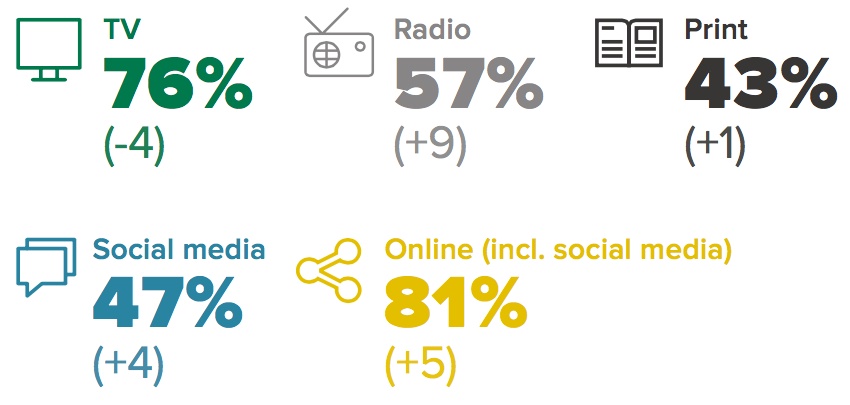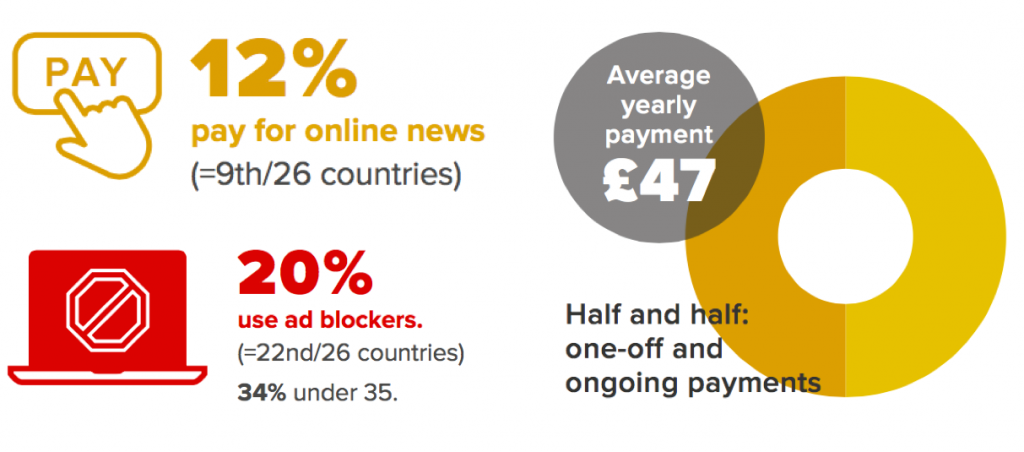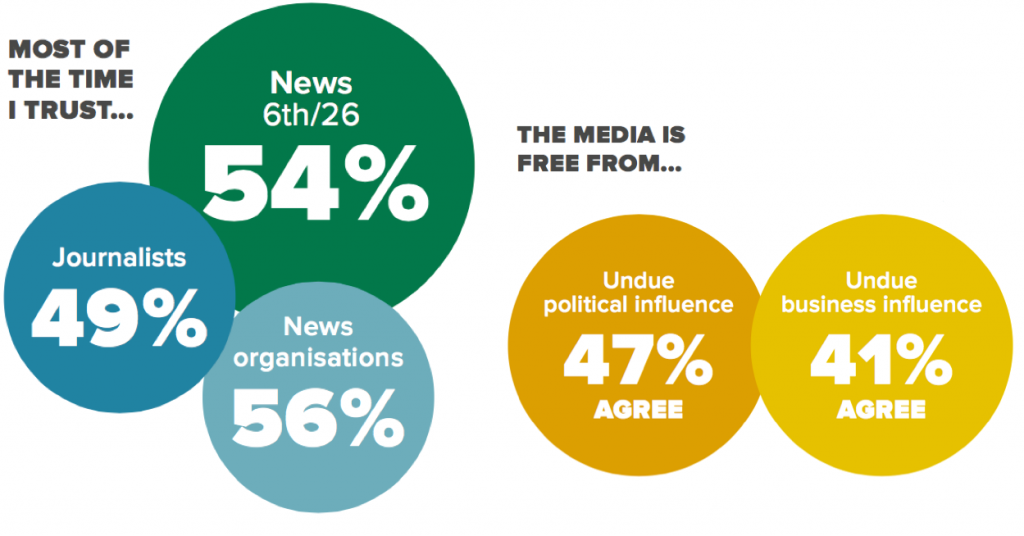| Statistics | |
| Population | 17m |
| Internet penetration | 96% |
The Dutch media market is characterised by a diverse public broadcasting system, a range of commercial broadcasters, a highly concentrated print sector, and a growing number of online-only players.
Top Brands % Weekly Usage (TV, Radio and Print)
| Weekly use | Main source | |
|---|---|---|
| NOS News | 61% | 29% |
| RTL news (inc. RTL Z and EditieNL) | 35% | 11% |
| A regional or local newspaper | 26% | 9% |
| SBS news | 23% | 4% |
| Other NPO TV news programs | 21% | 3% |
| De Telegraaf | 19% | 6% |
| Regional radio news | 16% | 2% |
| Regional TV news | 16% | 1% |
| Algemeen Dagblad | 15% | 6% |
| Commercial radio news | 15% | 4% |
| Metro | 13% | 3% |
| de Volkskrant | 8% | 3% |
| CNN | 8% | 0% |
| BBC News | 8% | 1% |
| Belgian TV news | 5% | 0% |
| German TV news | 5% | 0% |
Top Brands % Weekly Usage (Online)
| Weekly Reach | Main Source | |
|---|---|---|
| NU.nl | 44% | 25% |
| NOS News online | 32% | 11% |
| De Telegraaf online | 26% | 11% |
| Algemeen Dagblad online | 22% | 7% |
| RTL News online | 19% | 4% |
| Regional or local paper website | 17% | 4% |
| Regional TV news online | 13% | 2% |
| de Volkskrant online | 9% | 2% |
| MSN News | 8% | 2% |
| Geen Stijl | 8% | 1% |
| Regional radio news online | 7% | 1% |
| Metro online | 6% | 1% |
| CNN News online | 6% | 0% |
| BBC News online | 6% | 1% |
| SBS news online | 6% | 1% |
| Website of a free city paper | 5% | 0% |
Overview of key findings
By Joëlle Swart and Marcel Broersma
Centre for Media and Journalism Studies, University of Groningen
Dutch news organisations, both established brands and new players, are increasingly focusing on digital innovation. A variety of initiatives, ranging from De Correspondent (online quality news via subscription), Blendle (new aggregated distribution channel), and De Coöperatie (organising freelance journalists), are experimenting with new models for journalism in a digital era. At the same time, traditional media such as newspapers and television have to balance making money via their declining but still profitable offline products with moving their brands to online.
Dutch newspapers continue to face declining print circulations; only national quality papers de Volkskrant and Trouw managed to grow. The largest popular newspaper in the Netherlands, De Telegraaf, is struggling financially and has reduced its editorial staff, although it still remains one of the most important news brands in the country both online and offline. As a result of the decreasing revenues, we see a growing concentration of media ownership. In 2015, Belgian publishing house De Persgroep bought regional newspaper chain Wegener, and therefore now owns 45% of the newspaper market, with the Telegraaf Media Groep holding 35.2% of the market share. 1 Audience interest in start-ups initiated by traditional publishing houses, such as Mindshakes (NRC), Sportnieuws.nl (AD) or Paper (De Persgroep), remains low.
Because online advertisements yield little revenue – even though ad-blockers have not taken off to the same extent as in other countries – news publishers are seeking alternative sources of income. Blendle’s email newsletter generates micropayment sales, Yournalism allows journalists to use crowdfunding to support their reporting, and De Correspondent relies on yearly membership fees. Yet only a minority of Dutch news users spend money on news content: 88% did not pay for access to online news content in the last year.
Paying for news
The Netherlands is home to micropayment platform Blendle, which sells individual articles from a variety of publishers. Most newspapers have also set up paywalls and other direct subscriptions to drive revenue.
Trust
Trust in journalists and the media is relatively high in the Netherlands, which unlike, for example, the UK has not recently faced major scandals. There is no strong tradition of tabloid press, nor a history of ties between newspapers and political parties. Commercial broadcasters also bring detached-style quality journalism, comparable to public service broadcasters.
Scroll data area to see more
TOP SOCIAL NETWORKS*
| RANK | NETWORK | ALL | U35s |
|---|---|---|---|
| 1 | 36% | 45% | |
| 2 | 14% | 17% | |
| 3 | YouTube | 11% | 13% |
| 4 | 8% | 9% | |
| 5 | 5% | 4% |
- Commissariaat voor de Media (2014). Retrieved from: https://www.mediamonitor.nl/mediamarkten/dagbladen/dagbladen-in-2014/
Public broadcaster NOS remains the most important offline news brand in the Netherlands. Starting in 1999 far ahead of competitors, NU.nl continues to be the most popular Dutch news website, although newspapers De Telegraaf and Algemeen Dagblad and broadcaster NOS have caught up over the past 15 years. Local news remains popular amongst Dutch audiences with regional newspapers ranking third in the list of top offline news brands. Regional TV and radio news also score relatively highly.
Rating figures show that the time Dutch people spend watching live television has declined by 4.8% over the past year. [49. Stichting Kijkonderzoek Jaarrapport (2015). Retrieved from: https://www.kijkonderzoek.nl/images/SKO_jaarrapport_2015.pdf However, watching broadcasts on-demand or online is becoming increasingly popular, facilitated by services such as NPO Gemist (PSB), RTL XL (RTL), and Kijk (SBS). The Dutch Parliament has heavily debated proposals by Secretary of State Sander Dekker to revise the national Media Act to increase the power of NPO, the umbrella organisation of Dutch PSBs. The plan would also limit broadcasters to content that has a clear educational, informational, or cultural purpose. Opponents are concerned that this new policy limits the attractiveness of the public channels and extends the influence of politicians over PSB, especially after the appointment of one of Dekker’s party members to the board of NPO.
The widespread adoption of smartphones and tablets in the Netherlands has resulted in an increase in mobile traffic to news websites. Micropayment platform Blendle has grown its number of subscribers to half a million and recently expanded its pay-per-article services to Germany and the United States. Long-form journalism platform De Correspondent, founded in 2013, continues to grow and now has 36,000 members, more than the daily circulation of print newspaper nrc.next. [50. Dolf Rogmans, ‘De Correspondent weet groei vast te houden’, Villamedia, 2015. Retrieved from: https://www.villamedia.nl/artikel/de-correspondent-weet-groei-vast-te-houden. Wilco Dekker, ‘Oplagecijfers kranten stijgen dankzij digitale abo’s. de Volkskrant’, 2015. http://www.volkskrant.nl/media/oplagecijfers-kranten-stijgendankzij-digitale-abo-s~a3923288 ↩




